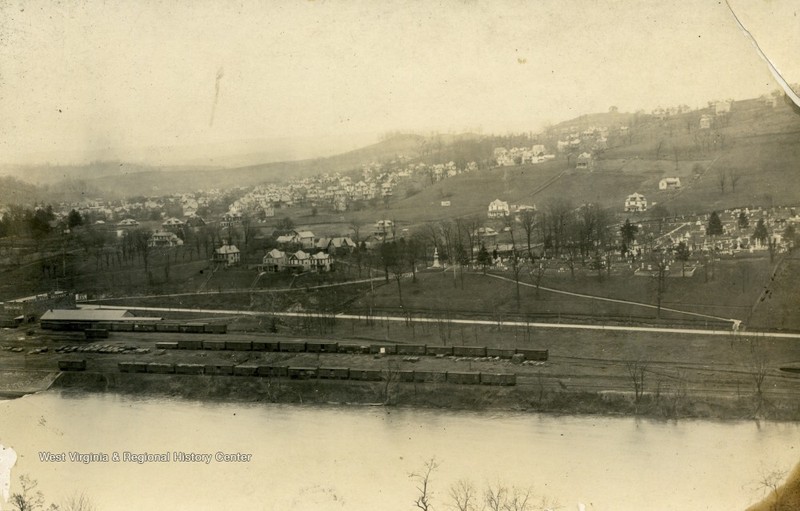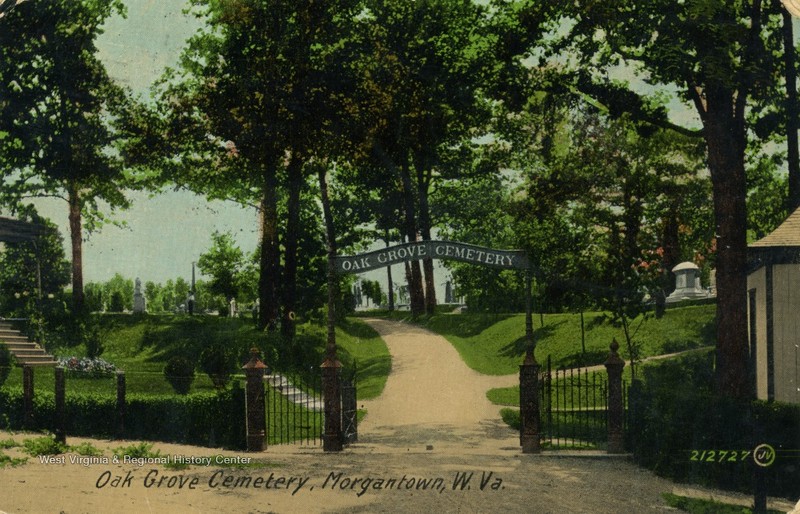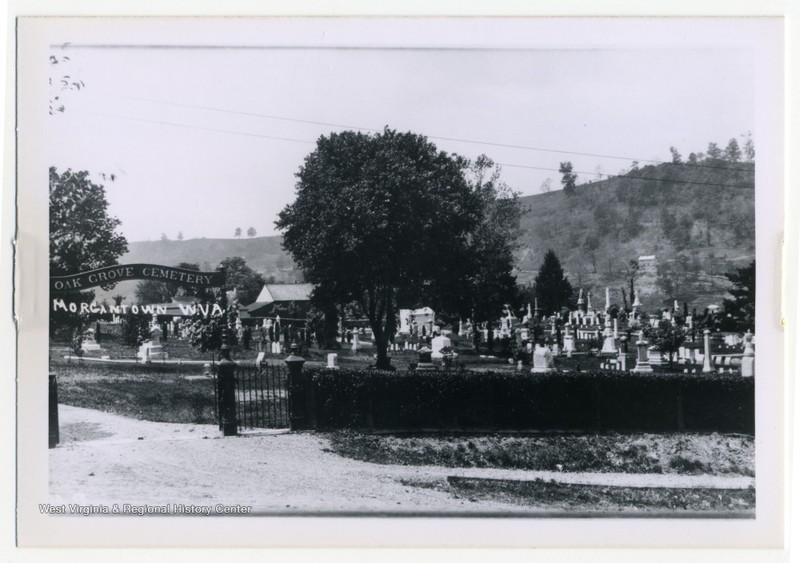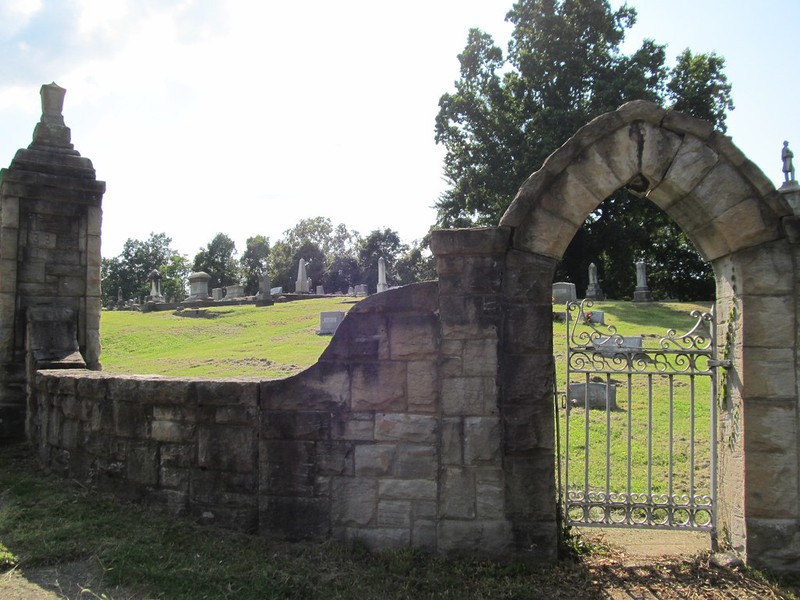This entry includes a walking tour! Take the tour.
Introduction
Text-to-speech Audio
Images
Oak Grove Cemetery from across the Monongahela River.

Postcard depicting the cemetery, ca. 1911.

Undated photo of Oak Grove Cemetery, likely early twentieth century.

The cemetery today.

Backstory and Context
Text-to-speech Audio
Beginning in the eighteenth century, burials commenced in the northwest corner of Oak Grove Cemetery before radiating roughly counterclockwise through the space. Several factors might have contributed to choosing the site of the cemetery. If the Oak Grove name alludes truthfully to the space, then the location would have been an attractive place for a cemetery. A grove would save the trouble of clearing underbrush and smaller trees, thus decreasing the necessary labor. Oak trees also possess symbolic power. Many traditions view oak trees as symbols of longevity, might, and fortitude. It is easy to imagine how these traits would have appealed to settlers in an often hostile and unforgiving land. Another appealing aspect of the Oak Grove Cemetery location could have been the proximity to the Monongahela River, as the cemetery would have been easily accessible by water.
The earliest burials in Oak Grove Cemetery are clustered into family plots. Typically, a roughly rectangular area is demarcated by a low stone wall. A large monument bearing the family name is often centered in the plot. The rest of the space in each family plot is filled with graves. Women were buried based on their married name, though many tombstones also list maiden names. Families, especially isolated families like those around early Morgantown, often had a private cemetery somewhere on their property. This makes the use of Oak Grove Cemetery somewhat puzzling. The burial site is not centrally located or conveniently accessible. For a family such as the Dents, who lived several miles outside of Morgantown, reaching the Oak Grove Cemetery would have been an extended daytrip. It is possible that burying the dead together was important to creating and solidifying community ties, which made the cemetery valuable beyond simply existing as a burial site.
The first marked burials in Oak Grove Cemetery took place in 1796; Mary Reed and Wilson Philander were interred in that year. However, there was a nearly fifteen-year gap before another burial took place in the cemetery. It was not until 1810 that Reed and Philander were joined by others. The reasons for this gap are unknown, though considering Morgantown’s tiny size at the turn of the nineteenth century, there could simply have been few or no deaths between 1796 and 1810. The burials in this first period of cemetery use are primarily from pioneer families such as the Dents, Evans, and Reeds. Burial markers from this early period are usually made of local limestone. The markers are carved with care, though time has severely weathered most of them, some to the point of illegibility.
The middle period of Oak Grove Cemetery’s history is characterized by the burials of founders and shapers of West Virginia and Morgantown as civic units. Morgantown remained relatively small in the nineteenth century, though the population boomed in the last two decades before 1900. Oak Grove Cemetery witnessed the interments of figures such as Waitman T. Willey, who cleared the way for West Virginian statehood, and Alexander L. Wade, who overhauled the public-school system. Most burials from the middle period are of politicians, civic leaders, or lawyers.
The final major period of Oak Grove Cemetery Use occurred in the twentieth century. The burials of politicians and civic leaders continued, though they were joined by increasing numbers of entrepreneurs, businessmen, and educators. As Morgantown expanded, more services and infrastructures were needed, leading to a shift in economy and culture. Additionally, West Virginia University became a key component of the community. The last plots in Oak Grove Cemetery were sold in the 1930s or 1940s. Despite this, burials have occurred as recently as 2011, as many families purchased an excess of plots well in advance of needing them. Unfortunately for Oak Grove Cemetery’s historical authenticity, many bodies were uninterred from other cemeteries and transferred to Oak Grove in the twentieth century.
Sources
DeVault, Janet. Personal conversation with author. September 30, 2020.
Selfridge, Jennifer. Oak Grove Cemetery, United States Graves Archives. February 12th 2004. Accessed October 12th 2020. http://files.usgwarchives.net/wv/monongalia/cemetery/oakgrove.txt.
Gibson, Scott. "Baltimore and Ohio Railroad Yard South and Oak Grove Cemetery; Morgantown, W. Va." West Virginia & Regional History Center. Accessed October 12, 2020. https://wvhistoryonview.org/catalog/043459.
"Oak Grove Cemetery; Morgantown, W. Va." Ca. 1911. West Virginia & Regional History Center. Accessed October 12, 2020. https://wvhistoryonview.org/catalog/043543.
"Oak Grove Cemetery, Morgantown, W. Va." West Virginia & Regional History Center. Accessed October 12, 2020. https://wvhistoryonview.org/catalog/053065.
Haldeman, Lorena. "Oak Grove Cemetery." 2013. Flickr. Accessed October 12, 2020. https://www.flickr.com/photos/92778929@N00/9576408148/.
